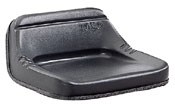Riding Powder Coating to the Top
When Michigan Seat Co. switched to powder coating, it virtually doubled the number of parts it could finish in one hour...
If you purchased a riding lawnmower a few years ago, you probably would have been sitting on a layer of high-solids liquid paint when you cut your grass. If you buy one today, however, you'll almost certainly be cruising the turf in a powder coated seat.
The firms that make the seats for riding mowers, forklifts and other cargo handling vehicles are switching from paint to powder. Michigan Seat Co., a 300-employee company in Jackson, MI, has made the switch to powder coating. "We're very, very satisfied," stated Bob Nelson, the firm's senior plant engineer. The company is a privately owned company that supplies seats to virtually every manufacturer in the riding lawn mower business and to some of the top makers of cargo handling trucks, which include fork lifts and other warehouse vehicles. "Our customer list includes every maker of riding lawn mowers across the board, from mass producers to custom manufacturers," according to Mr. Nelson. The firm had used a high-solids liquid paint on the seats. The liquid paint line used a monorail conveyor that took the newly made seats, hung two to a hook, through a three-stage washer then into facing spray booths. There, two robots—one in each booth—painted each seat. The seats then moved to a cure oven.
"The driving force on our going from liquid to powder was the environmental consideration," Mr. Nelson said. "When you use liquid paint, you've got to contend with VOCs, which are restricted by the Clean Air Act Amendments of 1990. We had a permit for about 39 tons of VOCs. But, we knew that sooner or later those restrictions would become tighter and tighter. With powder coating, you're exempt from those permitting requirements."
Powder coating has brought other benefits as well. "With powder coating, the density of parts on the line is a lot greater," Mr. Nelson explained. "We can move more material through per hour." The new line moves 1,040 parts per hour versus only 620 parts per hour with the wet paint system. On the powder coating line, now about 1 year old, parts move on a conveyor through a five-stage washer, a dry-off oven, the powder application booth and a cure oven. The powder coating booth uses 12 stationary guns and has an 8,000 cfm reclaim capability. The company has not done formal efficiency studies, but Mr. Nelson said, "We think overall we're using less labor per part than we did on the wet line." Bill Petrie, the company's maintenance superintendent, observed, "We still have a learning curve with how to deal with and handle the new equipment. Overall the decision we made has proved very satisfactory."
Michigan Seat began thinking about alternatives to liquid paint in the early 1990s, and chose powder coating after more than a year of rigorously analyzing alternatives to the paint they were using. "We looked at electrocoat and did about a year evaluation of it. Then we looked at autoferetic paint. Overall, we spent about 12 to 14 months evaluating alternatives and concluded that powder was our best bet," Mr. Nelson reported.
Once the decision was made, Michigan Seat's chemists, the superintendent of the painting system and the quality control manager visited a number of powder suppliers. "We chose a company that took us to several plants that were using their powder," Mr. Nelson reported. "We got the opportunity to ask questions and get ideas for the design of our own system." Michigan Seat also worked with hardware manufacturers to determine what powder system they needed. It chose one company to supply the powder application booth and guns as well as the reclaim system. And, it turned to another company with unique design ideas to purchase the washer, dryer, cure oven and conveyor systems.
Overall, Mr. Nelson is optimistic that the new powder coating system will contribute to his company's growth. "We built the powder coating equipment with the thought that our production would increase and powder coating would help us handle that. While we don't have plans to buy or install more equipment right now, it's the plan of every company to grow, and that's our intention too."
Read Next
Education Bringing Cleaning to Machining
Debuting new speakers and cleaning technology content during this half-day workshop co-located with IMTS 2024.
Read MoreA ‘Clean’ Agenda Offers Unique Presentations in Chicago
The 2024 Parts Cleaning Conference, co-located with the International Manufacturing Technology Show, includes presentations by several speakers who are new to the conference and topics that have not been covered in past editions of this event.
Read MoreEpisode 45: An Interview with Chandler Mancuso, MacDermid Envio Solutions
Chandler Mancuso, technical director with MacDermid Envio discusses updating your wastewater treatment system and implementing materials recycling solutions to increase efficiencies, control costs and reduce environmental impact.
Read More











.jpg;maxWidth=300;quality=90)








